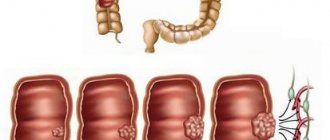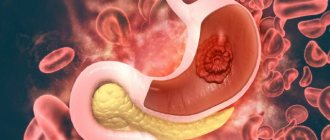One of the morphological characteristics of malignant neoplasms is the degree of their differentiation. Cell differentiation is the implementation of the genetic program embedded in them, thanks to which their development occurs and the ability to perform specialized functions. During malignant transformation, differentiation is disrupted, signs of atypia appear, and tissue structure is disrupted. In undifferentiated tumors, the changes are so severe that they cannot be identified with any tissue. Such cells cannot perform any functions except nutrition and reproduction.
- Causes and risk groups
- Classification
- Symptoms of stomach cancer
- Diagnosis of undifferentiated cancer
- Treatment of undifferentiated cancer
- Recovery after treatment
- Metastasis
- Complications
- Prognosis and prevention
Undifferentiated adenogenic gastric cancer is a malignant tumor that has pronounced signs of atypia, is characterized by a malignant course, a tendency to rapid metastasis and local spread.
Undifferentiated gastric cancer is a malignant tumor that has pronounced signs of tissue atypia, is characterized by an extremely high malignant course, and a tendency to rapid metastasis and local spread.
Classification of tumors depending on cell differentiation
To understand what undifferentiated gastric cancer is, you need to understand the meaning of the term “cell differentiation.” By this concept, doctors mean the genetic program embedded in them, thanks to which cells are able to perform certain functions. During the process of malignancy, differentiation is disrupted, signs of atypia develop, and the structure of the affected tissues changes.
Malignization can occur at different stages of cell development. Depending on this indicator, doctors divide stomach cancer into four categories:
- highly differentiated
- has a low level of malignancy. Almost fully formed cells capable of performing the tasks inherent in them undergo degeneration; - moderately differentiated
- acts as a transitional form, has an average degree of malignancy; - low-differentiated
- consists of tissues that have practically lost their resemblance to healthy ones. Actively metastasizes; - undifferentiated adenogenic
) - refers to the most aggressive types of carcinomas. Cells are atypical, deprived of the ability to perform all functions except division and nutrition.
The cells of adenogenic tumors mutate so much that they cannot be compared with any tissue.
Features of adenogenic disease
Undifferentiated carcinomas have a number of distinctive characteristics. The main ones:
- lightning speed of growth, metastasis;
- predominance of infiltrative spread in surrounding tissues;
- the most common localization in the proximal part, or total damage to the organ;
- ulceration of carcinoma, metastasis in the early stages of development;
- loose type of growth.
Adenogenic cells have an irregular shape and different sizes (from similar to lymphocytes to giant, multinucleated ones).
Symptoms of stomach adenocarcinoma
The most common symptom of stomach cancer is pain. The degree of its manifestation is not related to the amount of food consumed or the time of its consumption. This symptom is complemented by nausea, vomiting, belching, and loss of appetite. Systematic stool disorders (constipation or diarrhea) lead to weakness, apathy, and weight fluctuations. The patient may lose the feeling of pleasure when eating food, the taste of familiar dishes will be perceived differently.
Local symptoms often appear after the tumor begins to affect the functioning of the stomach. A neoplasm in the outlet section provokes a narrowing of the pylorus, which separates the organ from the duodenum. When the internal parts of the stomach are affected, the patient does not notice any signs of cancer for a long time until symptoms of general intoxication of the body appear.
A tumor in the cardiac region provokes dysphagia (difficulty swallowing). Significant size of the tumor can prevent the passage of liquid food through the stomach. The growth of cancer cells into neighboring organs significantly affects the clinical picture of the disease.
Types of undifferentiated tumors
Adenogenic carcinomas come in several types:
- solid - have a dense structure. Grow between connective tissues;
- fibrous - consist of hyperchromic malignant cells, localized between strands of coarse fibers;
- signet ring cells (mucous, colloid) - synthesize a large amount of secretion. They resemble a mass of mucus containing ring-shaped malignant cells. They are quite difficult to detect.
Regardless of the type, undifferentiated tumors quickly cover a large area of the affected organ.
Causes of the disease
The reasons for the mutation of healthy cells into malignant ones have not been reliably established. Doctors have identified a number of factors that increase the risk of developing adenogenic carcinoma of the organ.
Among them:
- genetic predisposition. The likelihood of carcinoma growth increases in patients whose immediate family members have had cancer;
- living in a region with an unfavorable environmental situation;
- smoking;
- a diet based on smoked meats, semi-finished products, pickles, food additives,
- malabsorption of nutrients;
- alcohol abuse;
- AIDS, HIV;
- colonies of Helicobacter pylori in the organ (increases the likelihood of carcinoma by 10-12 times);
People who have been diagnosed with diseases related to precancerous conditions should be especially attentive to their health.
The degeneration of cells and the spread of neoplasm occurs gradually. The earlier the pathology is identified, the greater the chance of prolonging the patient’s life.
Causes and risk groups
The reasons for the development of adenogenic gastric cancer are not fully understood. What is known for certain is that a healthy cell degenerates into a malignant one under the influence of oncogenic processes or mutations. The following factors can lead to their occurrence:
- Chronic gastritis of atrophic type. In this case, the localization and extent of its spread are important. If foci of gastritis are localized in the body of the stomach, the risks increase by 3-5 times, with damage to the antrum - by 18 times, and with total damage, the risks increase by 90 times.
- Features of the diet include consuming a large amount of spicy foods, smoked foods, marinades, and alcohol.
- Helicobacter gastritis.
- Smoking.
- A history of gastric surgery.
- Hereditary predisposition.
- Working with carcinogenic substances - asbestos, chemical production, etc.
The risk group includes people with stomach diseases, such as gastritis, polyps, ulcers. In order to detect the development of cancer in time, they are recommended to undergo regular examination by a gastroenterologist.
Stages of disease development
Like other forms, adenogenic cancer goes through several stages of development:
- 0 — changed tissues remain within the boundaries of the epithelial layer of the organ wall;
- I - carcinoma grows into the muscle layer;
- II - malignant tissue grows deeper into the wall of the stomach. Possible metastases to regional lymph nodes;
- III - cancer affects the serous membrane, leaves the cavity, spreads to the nearest internal organs, lymph nodes;
- IV - metastases are found in the tissues of distant internal organs and lymph nodes.
Since a feature of undifferentiated gastric carcinoma is rapid progression, it is usually discovered in late stages. The initial signs of the disease are nonspecific, patients attribute them to a mild disorder, and consult a doctor when the situation becomes irreversible.
Diagnosis of pathology
After compiling the patient’s medical history, the oncologist begins an objective examination. Typical areas of gastric cancer metastasis are studied most thoroughly: lymph nodes of the neck, liver, lungs, and ovaries in women. An accurate diagnosis is made based on:
- gastroscopy, which allows visualization of pathological changes in tissues;
- X-ray of the stomach, which provides diagnostics of the condition of the internal walls of the stomach;
- endosonography, which creates conditions for identifying metastases and performing a biopsy of suspicious areas;
- blood tests containing data on tumor markers;
- histological studies, making it possible to determine the degree of differentiation of cancer cells.
Hardware diagnostic methods play an important role when planning surgery. Magnetic resonance imaging and computed tomography are used to identify the size of the tumor and determine the extent of damage to adjacent organs and tissues. Differential diagnosis allows you to exclude gastritis, ulcers and gastric polyps from the patient’s diagnosis.
Symptoms of undifferentiated cancer
In the initial stages, adenogenic carcinoma does not manifest itself in any way. Some patients experience minor intestinal disorders accompanied by occasional diarrhea.
As undifferentiated carcinoma develops, the patient develops local and general symptoms of the disease.
The first include:
- pressing pain in the epigastrium at night of varying intensity:
- belching with the smell of rot;
- nausea;
- heaviness, discomfort in the stomach after eating;
- lack of appetite;
- heartburn;
- difficulty swallowing (if carcinoma is located in the cardia);
- change in taste (aversion to meat and fish is more common);
- satiation with small amounts of food;
- repeated vomiting after eating;
- constipation alternating with diarrhea.
Among the general signs of an adenogenic organ tumor:
- sudden, rapid weight loss;
- fast fatiguability;
- sleep disorders;
- increased body temperature;
- weakness;
- anemia;
- fever;
In the later stages of development of adenogenic carcinoma, the severity of symptoms increases. The pain becomes constant, severe, and painful for the patient. Fluid may accumulate in the peritoneum (ascites). When the tumor grows into blood vessels, the patient experiences vomiting mixed with blood, diarrhea, the color and consistency of which resembles coffee grounds, which indicates bleeding in the organ. When metastases spread to neighboring organs, the clinical picture is complemented by intestinal, pulmonary, and cardiac symptoms.
Stomach cancer
Stomach oncology
occurs in the tissues of the mucous membrane of this digestive organ.
Glandular epithelial cells of the gastric wall begin to divide uncontrollably, forming a malignant tumor. The average age at which this disease is most commonly seen in patients is around 65 years. But the range of statistical observations ranges from 40 to 70 years, so being informed about this cancer is very important to know what to do if you are diagnosed with stomach cancer
.
A feature of the course of oncology in this organ is rapid metastasis, that is, cancer cells through the walls can affect adjacent organs. Once this happens, the cancer is much more difficult to fight, which is why it is very important to diagnose it at the earliest possible stage. The main form of gastric cancer is adenocarcinoma, and only in five percent of cases are other variants found.
Causes
Despite all the successes of modern medicine, the reliable causes of stomach cancer are still unknown. However, most researchers agree that the bacterium Helicobacter Pylori plays a significant role in the sudden onset of this disease. This is the same bacterium that relatively recently began to be considered the root cause of peptic ulcers. Now traces of its destructive activity can be traced in the formation of tumors.
However, there are other factors that cause stomach cancer:
- Abuse of tobacco and alcohol - these bad habits not only cause toxic formations, but also directly damage the mucous membrane (with ethyl alcohol);
- Toxic substances - these include cosmetics, the excessive use of which can provoke cell changes, as well as nitrates and nitrites. The latter can often be found in products such as vegetables from fields where strong fertilizers are used, smoked products, and dried fish.
- Medicines can become not only a means of relief, but also a cause of damage to the mucous membrane. Therefore, you should not abuse strong drugs that affect the organ lining. Both an ulcer and a cancerous growth may occur.
- Irradiation - radioactive rays are used in therapy against cancer, but can also cause cell mutation and tumor formation;
- Chronic diseases of the digestive tract and gastric region;
- Previous operations in this area of the body;
- Heredity - the occurrence of similar diseases in relatives of different generations is not news today, therefore control and constant examination in people from this group should be mandatory.
At the same time, doctors note a number of conditions in which the occurrence of tumor processes is significantly increased. Those that cause stomach cancer include peptic ulcers, adenomas and atrophic gastritis. However, the presence of these risk factors does not mean that the disease will necessarily manifest itself sooner or later. Even if a number of carcinogenic factors coincide, a person can easily live to a ripe old age, just as he can get sick, even if such factors are absent in his life in principle. According to statistics, the risk of getting sick is higher in men, since gastric tumors are one and a half or more times more common in them than in women. Older people are also statistically more likely to get sick. Those who are included in the groups described need to know how stomach cancer manifests itself. Symptoms A huge problem is the absence of visible signs of the disease to a person at the time of its occurrence. Symptoms of stomach cancer are felt only when the disease reaches the second or even third stage. Medicine identifies the first signs of stomach cancer:
- Pain syndrome in the supragastric region;
- Constant heartburn and bloating;
- Nausea and vomiting - when a malignant neoplasm clogs the pyloric region and the passage of food decreases;
- Appetite decreases, the body is not satisfied, and the person loses weight;
- Difficulty swallowing - when the tumor grows into the upper part of the organ;
- With further development of the disease, early saturation syndrome may occur, when all layers of the walls are affected, and its ability to stretch weakens.
Should you sound the alarm if you or your loved ones develop symptoms? In fact, the symptoms are similar to the descriptions of dozens of other gastrointestinal diseases. Therefore, if the first signs are observed, it is necessary, without delay, to visit a doctor in order to make an accurate diagnosis.
Symptoms of later stages include:
- Stomach bleeding;
- High fatigue;
- State of weakness and apathy;
- Refusal of food.
Stages of stomach cancer
They are distinguished by the diameter of the tumor, as well as the degree of its prevalence in the human body. To accurately determine how quickly stomach cancer develops, you should know whether the lymph nodes are affected, and how far the metastases have penetrated to distant (from the source) parts of the body and internal organs.
This is cancer at the moment of its occurrence. It has not yet grown into the mucous membrane, does not have any harmful effects, and therefore does not give any clinical manifestations. And it is discovered only by chance, if an examination is carried out for another reason.
Stage 1
The diameter is rarely more than 2 centimeters. It already affects the mucous membrane and can affect the muscle membrane. Even at this stage, metastases sometimes reach the lymph nodes located near the site of the disease. No traces of cancer cells are observed in distant internal organs.
Stage 2
The tumor is already growing up to 5 centimeters. The subserosal membranes are also affected. Local lymph nodes are also affected. When the tumor spreads, from 1 to 7 lymph nodes in the area of the outbreak are affected. No traces of cancer cells are observed in distant internal organs.
Stage 3
Compared to the previous stage, the tumor may be almost twice as large. At a minimum, it affects the mucous and muscular membranes, but over time penetrates the subserosal and serous membranes. Thus, each layer of the walls of the digestive organ is affected. This stage may be characterized by the tumor leaving the digestive system and spreading to nearby organs. No traces of cancer cells are observed in distant internal organs.
Stage 4
It is not characterized by specific parameters and tumor location. A special feature is the appearance of metastases far from the site of the disease, most often found in the peritoneum, gastric artery, lymph nodes of the spleen, liver, kidneys, lungs or heart. Even the bones and brain can be affected. Metastases cause new malignancies, so cure at this stage is the most difficult. Moreover, the disease affects many lymph nodes in different parts of the body.
The initial stage is observed more often in the lower part of the organ. Scientists believe the cause is the retrograde movement of food when the normal functioning of the duodenum is disrupted; digested food returns to the stomach from the intestines. Initially, this can provoke gastritis, and then the appearance of tumor cells. However, the occurrence of malignant neoplasms can be observed in any gastric region.
Survival prognosis for stomach cancer
Survival rates for stomach cancer are closely correlated with the time of detection. So, if it was found soon after its appearance, then the chances of recovery are more than 70%, and five-year survival rate (that is, the chances of surviving 5 years from the date of diagnosis) is observed in 80% of patients. However, as can be seen from the descriptions of the stages and symptoms of the first stage, cancer can be detected most likely by chance, when neighboring organs or the stomach are examined for ulcers or gastritis.
Even the second stage is diagnosed extremely rarely, since it can occur without obvious clinical manifestations. If, nevertheless, it was possible to identify it, then five-year survival is guaranteed in 50% - 60% of cases.
Starting from the third stage, the prognosis becomes unfavorable. It is diagnosed more often, in approximately 15% of cases, but the five-year survival rate does not exceed 40%. Symptoms of the fourth stage are already pronounced, so most often oncology is detected at this stage (about 85% of cases). Since this stage is characterized by the spread of metastases to distant tissues, organs and lymph nodes of the body, the five-year survival rate is only 3-5%. And the disease itself progresses extremely quickly. Thus, it is possible to answer the question of how long people live with stomach cancer only after the most accurate diagnosis has been established and the stage of the cancer has been determined. The earlier it is detected, the higher the chances of not only prolonging the life of the patient, but also being completely cured.
Diagnosis and treatment of stomach cancer
The only option for diagnosing stomach cancer with high accuracy is to conduct a complete histological examination. To do this, you need a sample of tumor tissue, which is then sent to the laboratory. However, there are other ways to detect and monitor cancer.
- Gastroscopy is probing of the gastrointestinal tract. It is carried out using special equipment, which at the present stage is capable of not only taking samples of various tissues, but also filming in high resolution;
- X-ray – used both to check the gastric area in contrast (detects foreign tumors) and to check the lungs for the presence of metastases in the later stages of the disease;
- Ultrasound examination - is carried out to determine the extent of the tumor process, and also allows you to monitor the dynamics of changes in the diameter and location of the tumor;
- Tomography – multislice computed tomography and positron emission tomography are used in diagnosis. The latter allows, with the help of a small amount of irradiated glucose introduced into the body, to clearly determine the location of the tumor and the degree of its penetration into neighboring organs and tissues;
- Blood test - carried out using special tumor markers corresponding to a specific cancer disease;
- A stool test is used to check for traces of blood in the patient's stool.
Knowing the signs of this most dangerous disease, you can formulate several basic principles in order to prevent it. Ideally, it is necessary to monitor the mucous membrane of this important organ so that the slightest suspicion of oncology appears at the earliest stages of the disease. Then the chances of a cure are higher, and the fight against the tumor process will be more effective.
In addition, prevention involves a healthy lifestyle (proper nutrition, avoidance of alcohol and tobacco), as well as timely treatment of all diseases that can cause cancer. If possible, one should try to exclude toxicological factors, including the abuse of drugs and cosmetics that irritate the mucous membrane.
The only effective and radical treatment method is surgical intervention. Only removal of the tumor during surgery can prevent further spread and growth of cancer cells in the human body. All operations in this area can be divided into two types: subtotal and total gastrectomy.
The first involves partial removal of the organ, including all affected tissue. The second involves complete removal of the organ. In this case, the surgeon makes the decision about which gastrectomy to perform directly during the operation, determining how severely the walls of the digestive organ are damaged. In any case, the affected lymph nodes are also removed at the same time, as they can become a source of relapse. In addition, during the surgical intervention, other internal organs affected by the disease can be completely or partially removed.
Radiological methods and chemotherapy are also used as part of the treatment. However, both methods are auxiliary, since in the usual format they can have a negative effect on healthy organs located in close proximity.
In practice, this means that the radiological method (exposure to low doses of radiation) is used only during surgery and only with special equipment. So that only tumor cells are exposed to radiation. Radiation has a destructive effect on them and prevents their further division.
Chemotherapy is used in the form of taking special medications before and after surgery. The specific course and dosage is prescribed by the attending physician. At the same time, chemotherapy, as is known, also has negative consequences, such as inhibition of hematopoiesis, harm to the gastrointestinal tract, decreased immunity and hair loss in all parts of the body. Both auxiliary methods require good material support for the clinic and the presence of qualified personnel.
The main problem of this disease is that it is detected, as a rule, in the last stages.
In this case, a complete cure even with the most modern medical methods is almost impossible. Therefore, patients undergo palliative surgery. They are recommended in cases where it is impossible to remove altered cells without threatening the patient’s life. Palliative surgery only relieves pain and temporarily prolongs life. That is why it is so important to identify the disease as early as possible, as soon as the first symptoms appear, and immediately seek advice from an experienced oncologist. Association "Hello!" together with oncology specialists, she has developed a series of brochures from which patients and their loved ones can receive up-to-date information about modern diagnostics and treatment of stomach cancer, the possibilities of immuno-oncology, as well as psychological and legal support.
Diagnostics
Only a doctor can make a diagnosis of “undifferentiated organ cancer” based on a complete examination of the patient.
Diagnostic techniques used include:
- X-ray with a contrast agent - allows you to assess the level of gastric stenosis, the prevalence of malignant tissues, and see tumors that are not determined by other means (for example, submucosal);
- a blood test for the presence of tumor markers of organ cancer (REA, CA 19-9, CA 72-4) is more informative in monitoring the disease’s response to treatment and detecting relapses than in the primary detection of carcinoma;
- endoscopy with tissue sampling for biopsy, showing the size and nature of the tumor;
- abdominal ultrasound - demonstrates the presence of metastases in the peritoneal organs and lymph nodes;
- laparoscopy - needed to detect the growth of a malignant tumor into the serous membranes of the gastric wall;
- biochemical blood test - carried out to assess the general condition of the patient’s body;
- CT (MRI) - shows distant metastases, tissue damage to other internal organs.
If necessary, the doctor refers the patient for additional studies. Only after receiving all the results is the patient prescribed the optimal course of therapy.
Prognosis and prevention
The prognosis depends on the stage, but most often it is unfavorable. The five-year survival rate ranges from 15-18%. Considering that a tumor most often develops against the background of existing stomach problems, to prevent its development and timely diagnosis of precancerous conditions, it is recommended to undergo regular examination by a gastroenterologist.
The presence of highly qualified oncologists and related specialists on Euroonco’s staff allows us to select the optimal treatment. The use of the most modern treatment protocols allows us to achieve satisfactory results even in the most difficult cases.
Book a consultation 24 hours a day
+7+7+78
Treatment
The most effective way to combat adenogenic stomach cancer is a combination of several methods:
- surgical;
- chemotherapy;
- radial
The operation is carried out in two ways:
- subtotal resection - involves cutting off a part of an organ with a tumor, obligatory capture of surrounding tissues, as well as nearby lymph nodes to stop the spread of malignant cells;
- gastrectomy - complete removal of the stomach.
Attention: the difficulty of eliminating adenogenic neoplasms lies in their infiltrative rapid growth, which makes it difficult to determine the boundaries between healthy and malignant tissues.
More than 50% of patients with this form of cancer are considered inoperable. In these cases, operations are aimed at mitigating the main complications of the disease. The patient can undergo:
- removal of part of the carcinoma tissue;
- gastrostomy placement;
- installation of a bypass from the stomach to the intestines and other interventions.
Surgeries for adenogenic cancer are combined with other methods of influencing malignant cells.
Radiation and chemotherapy
Depending on the timing of application, chemotherapy treatments are divided into two categories:
- non-adjuvant - carried out before surgery to stop the growth of a malignant tumor, reducing its size to operable;
- adjuvant - prescribed 4-6 weeks after the intervention to reduce the likelihood of metastasis and relapse of the disease.
Radiation therapy is used in a similar way. Separately, these techniques are ineffective against adenogenic cancer, but significantly increase the effectiveness of surgical treatment.
If intervention is not possible, the patient is prescribed chemo-radiation therapy. It slightly increases life expectancy, but alleviates the general condition of the patient.
Doctors strive to place radioactive elements or chemotherapy drugs as close as possible to the malignant focus. For example, cytostatics are injected into the arteries through which malignant tissue receives nutrition. This method is called intra-arterial polychemotherapy.
Also, adenogenic neoplasm is affected by placing radioactive grains in the patient’s stomach. Such techniques make it possible to have the maximum destructive effect on altered cells, practically without affecting healthy ones.
Recovery after treatment
Since surgical treatment of stomach cancer involves complete or partial removal of the organ, the patient will face serious dietary restrictions, since the main burden falls on the small intestine. Therefore, the patient is prescribed a gentle diet, excluding the consumption of coarse, fatty and indigestible foods.
Particular attention is paid to the daily routine. The patient is advised to get plenty of rest and limit his workload in terms of daily activities. At the same time, it is advisable to maintain communication with loved ones, as this has a beneficial effect on the psycho-emotional state.
Forecast
The prognosis for undifferentiated gastric cancer in most cases is unfavorable. About 18-20% of patients overcome the five-year survival threshold. Much depends on the stage of development of carcinoma at which treatment was started.
Thus, in the case of successful surgery at stage I of the disease, up to 90% of patients live for more than five years, at stage II - up to 55%. After a relapse, the survival rate decreases to three months from its onset.
Attention: tumor recurrence in undifferentiated cancer in the first three years after surgery is diagnosed in 90% of cases.
If the adenogenic form of cancer was detected at stage IV, the prognosis is extremely unfavorable. Most patients die within a year. Only a few live for five years.
Metastasis
Undifferentiated gastric cancer can metastasize by lymphogenous, hematogenous and implantation routes. With lymphogenous metastasis, regional lymph nodes localized in the abdominal cavity, retroperitoneal space and paracardial region are initially affected. Then more distant collectors are affected - supraclavicular, axillary, pararectal lymph nodes. With hematogenous metastasis, the liver, lungs, kidneys and other organs are affected. Implantation metastasis occurs through contact of tumor cells with the receiving surface. In this case, these are the peritoneum, diaphragm, pericardium and pleura.
Prevention
No specific methods have been developed to prevent the development of undifferentiated gastric carcinoma. To minimize risks, patients must follow these rules:
- give up bad habits (smoking, drinking alcohol);
- fill the diet with vegetables, fruits, meat, low-fat fish, foods rich in vitamins A, C, B, E, carotene;
- use water filters;
- do not overeat;
- avoid stress;
- reduce the consumption of fatty, fried, spicy, salty foods, preservatives;
Annual preventative examinations should not be neglected. Immediately treat identified diseases of the gastrointestinal tract.
Undifferentiated gastric cancer is a severe pathology that is difficult to treat. However, modern methods of combating the disease make it possible to achieve long-term remission and improve the patient’s quality of life. The main thing is not to “turn a blind eye” to health problems, consult a doctor in a timely manner, and carefully follow all recommendations.
has been organizing high-quality individual medical care for many years.
Over the years of work, we have accumulated statistics on leading foreign clinics and are ready to recommend to patients for pregnancy management after breast cancer only those medical centers where they will truly provide the most effective care.
Complications
- Bleeding from a tumor. They manifest as coffee-ground vomit and tarry stools (melena). In this case, an urgent endoscopic examination and an attempt to stop the bleeding are performed. If unsuccessful, laparotomy is performed.
- Tumor stenosis. This complication leads to the inability of food to move through the digestive tract and the development of nutritional disorders. To eliminate stenosis, recanalization, balloon dilatation, and stenting are used. In severe cases, bypass anastomoses are performed or a gastrostomy tube is removed.
- Ascites is an accumulation of fluid in the abdominal cavity. Intracavitary chemotherapy is used to combat ascites. For large volumes of liquid, laparocentesis is performed - evacuation of the contents through puncture.








